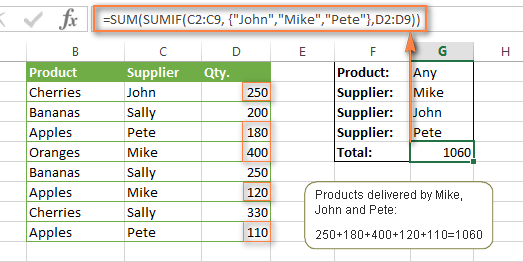


Each quarter, the four divisions are required to submit sales reports detailing the month of sale, the sales person, the car color and the price the car was sold for. Ivana Car Sales has four divisions, cunningly called North, South, East and West.

The functionality is best explained by walking through an example: You can check out Liam’s previous articles at where you can also subscribe to the monthly tips and tricks newsletter.Įver had to sum data based on multiple criteria situated in different Microsoft Excel worksheets? This article provides a quick tour of INDIRECT references and Table functionality while combining qualities of the SUMPRODUCT function with the SUMIFS function, providing a solution to the mother-of-all Multiple Criteria problems. A senior accountant and professional mathematician, he has worked in numerous countries with many internationally recognized clients, providing and reviewing strategic and operational models for various key business assignments. This wildcard is useful when you must locate something in a specific position within a set of text.Liam Bastick has provided financial modelling services and training to clients for more than two decades. Question Mark (?) – This wildcards character will allow for any character in a single character position. There are two wildcard characters:Īsterisk (*) – This wildcard character will allow for any character(s) in any quantity.Įxample 1: Exc* (any text starting with “Exc”)Įxample 2: *el (any text ending with “el”)Įxample 3: *xce* (any text with “exc” anywhere in the text beginning, middle, or end)Įxample 4: Exc*el (any text starting with “Exc”, ending with “el”, and any character in between) Wildcards represent “any characters” and are useful when you want to capture multiple items in a search based on a pattern of characters.

I have also covered a technique to sum values between two dates using the SumIFs and EOMonth functions. I have covered the mechanics of filtered aggregations ( SumIFs, CountIFs, and AverageIFs) in a previous post. Although, this is how these functions are typically used, this is not the case. MinIFs – find the smallest value in a set based on one or more criteriaĪlthough these are fantastic functions, most users are under the impression that the criteria must match entirely in order to be included in the aggregation.MaxIFs – find the largest value in a set based on one or more criteria.CountIFs – count based on one or more criteria.AverageIFs – average based on one or more criteria.SumIFs – sum values based on one or more criteria.This post will demonstrate how to perform a filtered sum of values based on a partial text match.Įxcel will allow you to perform filtered aggregations with the following functions:


 0 kommentar(er)
0 kommentar(er)
